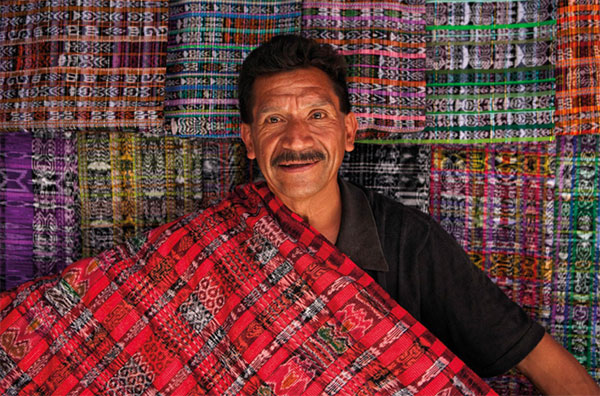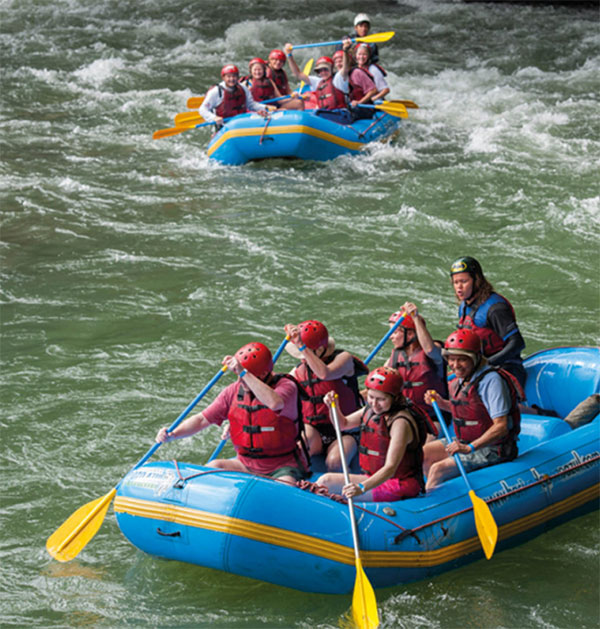INSIGHT: CRAFTS
Despite the efforts of the conquistadors, the Maya and other Indigenous groups of Central America carry on many craft traditions from their ancestors.
Unique styles of textiles, ceramics, carving and jewelry have developed across Central America, many dating from the days of ancient civilizations. Many cultures have their own form of ceramics, such as the Guatil in Guanacaste, who create pottery decorated with beasts that are half-bird, half-man, and people with exaggerated genitals, suggesting a fertility-rite culture. In western Honduras, the Lenca are known for their ceramics decorated with black and white geometric designs.
Textiles are important as well. In the Kuna culture on Panama’s Caribbean coast, molas (traditional clothing) originated with the tradition of body painting geometrical designs but are now a hand-sewn appliqué method on pieces of cloth. In the Guatemalan highlands, intricate weavings are made on simple hip-strap looms identical to those used by the ancient Maya, which consist of nothing more than a series of sticks. They’re decorated with a wide range of bird, animal, and plant motifs as well as geometric forms, many of which figure in Maya mythology. Some are recalled from memory, without the use of patterns. Momostenango, near Quetzaltenango, is Guatemala’s best place for traditional woolen blankets.
Masks, carved from balsawood or woven from plant fibers, are a common form of folk art in dozens of Indigenous cultures in the region, such as the Boruca in Costa Rica, the Emberá in Panama, and Maya in Guatemala. Often used for ceremonial purposes, many designs merge human, spiritual, and natural elements. Basketry, made of palm, wicker, or bamboo, is another age-old process that has changed little in centuries.

A Mayan man displays his traditional wares at the Textile Market in Tecpan.
Fair trade products
While many handicrafts produced in Central America are of extremely high quality, much of what is found in markets and souvenir stores are cheap, mass-produced designs that sell for a fraction of the costs of an original handmade item, which was constructed using a centuries-old tradition. Many tourists are fine with paying less and having more ponchos and straw baskets, though they should be aware that little of that money goes toward the community from which they bought it.
Authentic Indigenous handicrafts might cost just a little bit more than the items produced by a machine, though the benefits they give back to those who produce them are tenfold. The creation of handicrafts is fundamental for many Indigenous groups all over the world, mostly because they can be produced with relatively limited resources. For women and families, it is one of the most accessible forms of income available to them – even though they are often subjected to exploitation, such as getting unfair prices for the work they do. The term fair trade gets thrown around a lot in the region, often in relation to coffee, but it’s important for craftsmen and women too. To prevent unfair trading practices, many NGOs help to inform producers about their rights and the worth of their skills and help them organize into cooperatives to enable producer empowerment.

Tourists whitewater rafting at Pozo Azul near Virgen de Sarapiqui in Costa Rica.
ADVENTURE SPORTS AND ACTIVITIES
Adventurers: behold a compact world with abundant opportunities to surf world-class waves, dive primeval coral reefs, raft raging rivers, and hike jungle trails.
Central America is one of the world’s great destinations for outdoor enthusiasts. With two oceans to choose from, not to mention mountains, active volcanoes, and vast expanses of undisturbed forests, there’s no shortage of opportunities for adventure. This diverse landscape boasts rainforest trails for hiking, beaches for horseback riding, remote trails for mountain biking through isolated villages, and world-class kayaking and whitewater rafting. Along the Caribbean coast, you’ll find the world’s second-longest barrier reef where you can scuba dive, snorkel, or swim with whale sharks, while in the Pacific there’s superb surfing and sport fishing. Adrenaline sports such as ziplining, paragliding, and bungee jumping are on the rise – but note that there is little regulation of the adventure travel business, so choose your operator with care.
For a wet and wild adventure, try waterfall rappelling. Instead of zipping along a cable, you step off the top of a waterfall and rappel your way down, attached to ropes secured by guides at both the top and bottom of the waterfall.